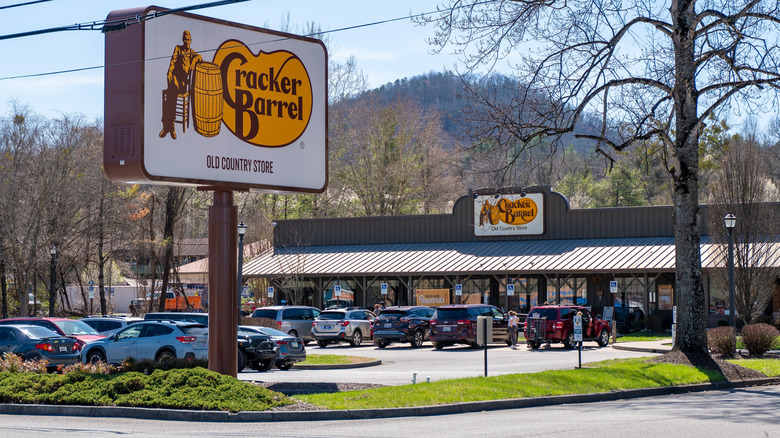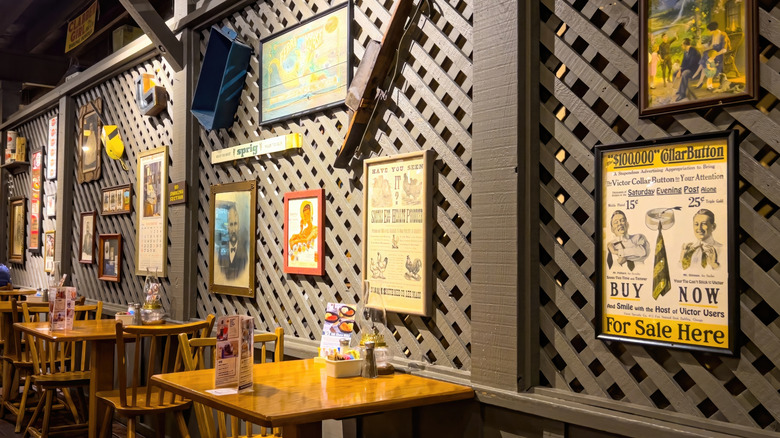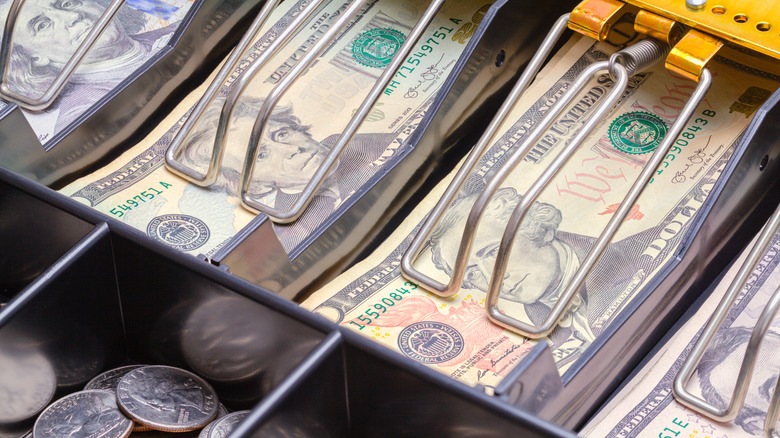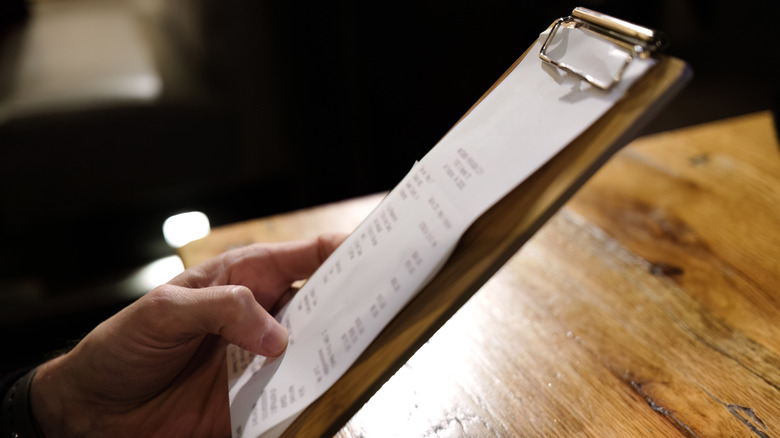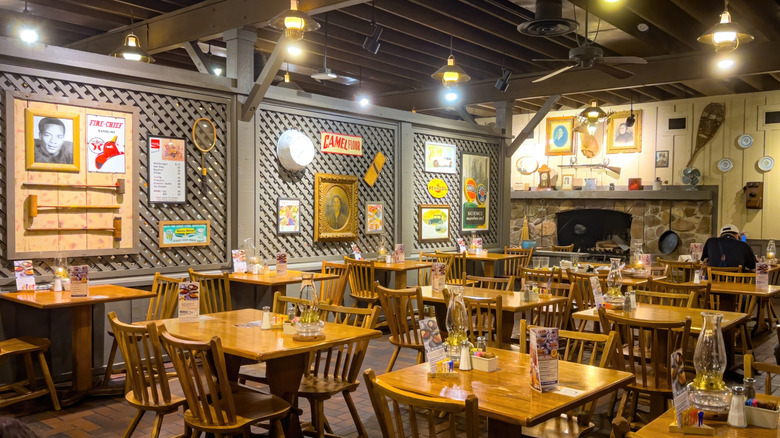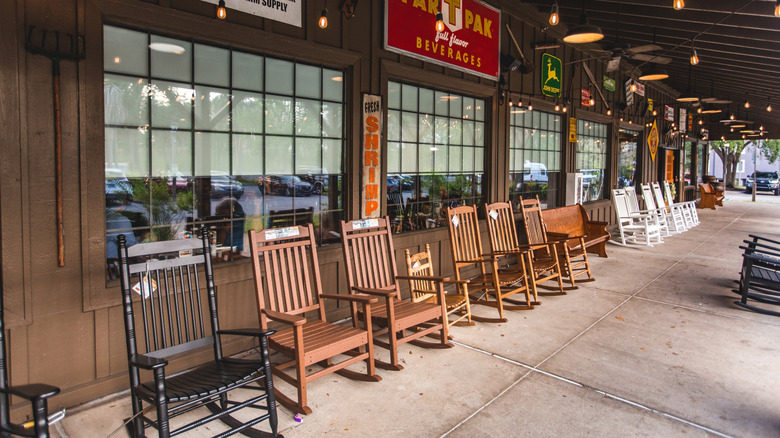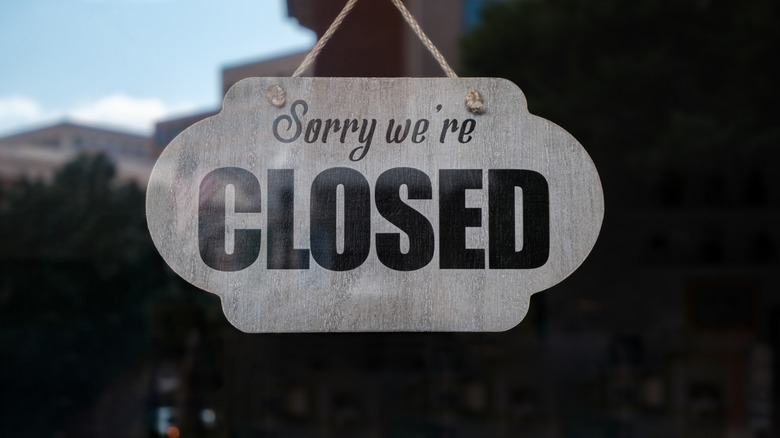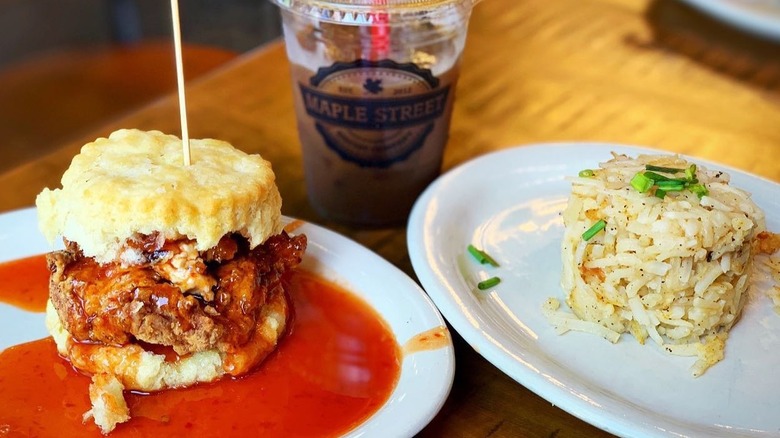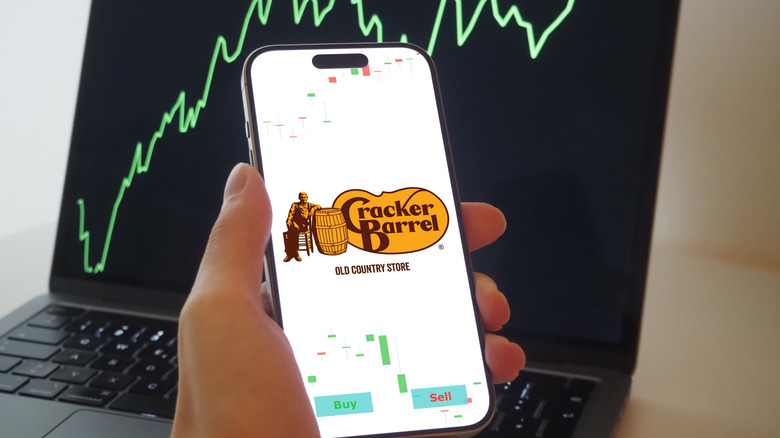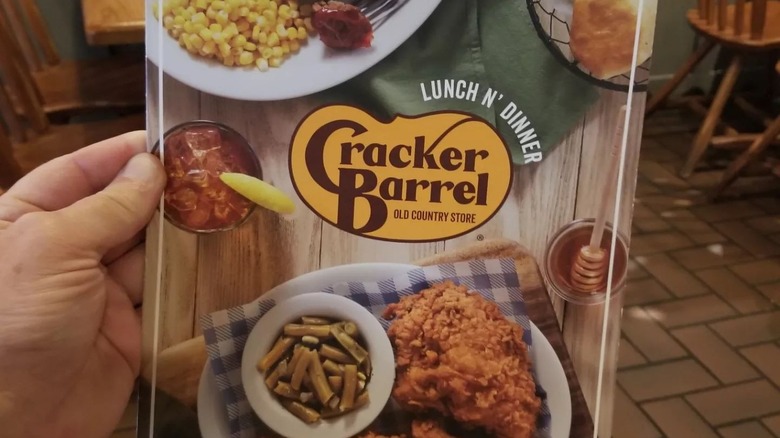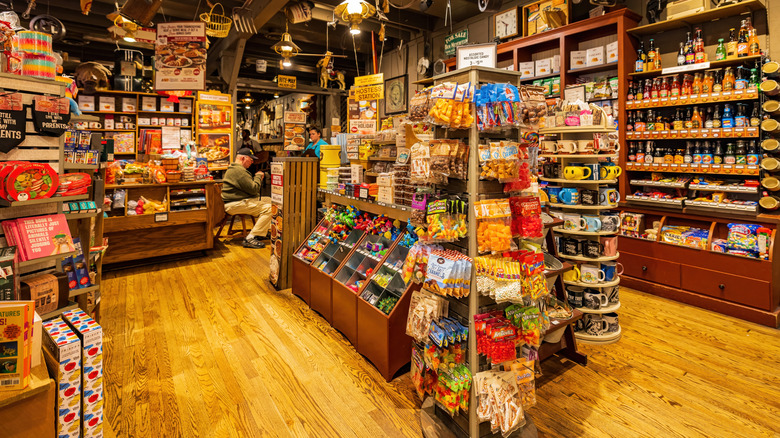12 Signs Cracker Barrel Isn't Doing So Well
While the restaurant industry has generally returned to pre-pandemic levels, with the National Restaurant Association even predicting $1.5 trillion in sales for 2025, that doesn't mean that every restaurant is doing equally well. And while chain restaurants thrive, dining suffers, as many full-service restaurants are still struggling to bring in customers. And 2024 was particularly hard for the industry, with two of the biggest names in the business, Red Lobster and TGI Fridays, filing for Chapter 11.
Another restaurant that's been on shaky ground since the pandemic is Cracker Barrel, the Southern-style casual dining restaurant that combines the homey cuisine of a country kitchen with the folksy decor of a country garage sale. Known for its large portions, even larger gift-shops and porches full of rocking chairs, the brand has carved out a beloved niche amongst its competitors that helped it spread to 657 stores across the country,ensuring that there are only a few states in the U.S. where you won't find a Cracker Barrel.
And while it still has legions of devoted diners, there's been plenty of speculation about Cracker Barrel struggling financially, with rumors even spreading that it was planning to close completely. And while those reports never came true, there are signs that Cracker Barrel's been having a rough time of it lately, with investor shakeups, lower attendance and even closing stores. Let's break down some of the biggest signs that Cracker Barrel might be starting to crumble.
1. The CEO admitted Cracker Barrel's just not that relevant
If you're looking for a big sign that a company is struggling, it's hard to top the CEO just flat-out saying that the company is out of date and behind the times. But that's what happened in a May 2024 investment call, where Cracker Barrel CEO Julie Felss Masino told investors that "We're just not as relevant as we once were ... some of our recipes and processes haven't evolved in decades."
And Masino, a former Taco Bell executive who became the Cracker Barrel CEO in 2023, definitely has a point, as Cracker Barrel hasn't changed much since it was founded in 1969. But that was actually a selling point, as it appealed to diners' nostalgia through its comfort food and the old-timey gift shop that goes with it. And when you're appealing to nostalgia, you don't want to embrace change, which is why the stores have largely remained the same for over half a century, and even why Cracker Barrel has that peg game. Because there's just something comforting about knowing that you'll be walking into the same country-style decor you've always known and that you can order the same food you've always ordered. But that nostalgic appeal does make it hard to innovate and to connect with younger, less nostalgic diners, as they know that this is, quite literally, their grandma's Cracker Barrel.
2. Cracker Barrel's sales levels have flattened out
If there's one thing a healthy company wants to brag about, it's financial growth. But during that 2024 call, the CEO also admitted that its sales levels had flattened out, with first quarter earnings of $935 million, the same as the year before.
Why isn't Cracker Barrel growing? Well, it doesn't help that 2024 has also been a hard year overall for casual dining chains, with those multiple bankruptcies we mentioned earlier and even large chains like Denny's closing 150 stores across the country. One reason is rising labor costs, as faster employee wage growth has been eating into full-service restaurants' profits. According to a study by point-of-sale company Square, wages for full-service workers have grown 73.9% since 2017. (By comparison, quick-service restaurants have only gone up by 60.2%, which is one of the reasons they're doing better than full-service chains).
Cracker Barrel's response to those labor costs has been to reduce labor in back of house operations, mentioning that some longtime processes could be overhauled, like hand-cutting lettuce and pineapple. And while Cracker Barrel's sales did increase slightly in the fourth financial quarter of 2024, it was only by .04%. Which is encouraging, but not the kind of big changes the chain needs to pull off if it hopes to survive.
3. Cracker Barrel raised its prices
When a restaurant's struggling, one obvious way to raise revenue is to hike up the prices. And that's what Cracker Barrel did in 2024, instituting a 4.9% increase on menu prices. That's actually higher than many of its competitors, as overall restaurant menu prices only rose 3.8% in 2024. But bigger bills aren't exactly the best message to send out when you're also trying to tempt budget-conscious potential customers to go out dining, especially since grocery prices only rose 1.1% during the same time. And faced with getting less food for their buck, it's easy for potential patrons to just stay home and make their own food. Especially since Cracker Barrel prides itself on offering home-style cooking.
That said, the price hikes weren't actually across the board, as CEO Julie Felss Masino tested out several different pricing strategies for stores, with 150 stores raising prices, while 70 others lowered them. She also added different value points to the menu, including a discounted early dinner menu and an upgraded offering of steaks at a higher price point, to appeal to both cash-strapped customers and people looking to splurge. Here's hoping this attempt to please different styles of customers will bring in more business.
4. It's having trouble attracting younger customers
Another sign of a healthy business is the ability to draw in new (and often younger) customers. But as a nostalgia-based brand, Cracker Barrel has always aimed for an older crowd, with a target demographic of 65 or older. In fact, company data from 2023 showed that 43% of Cracker Barrel guests are at least 55 years old, and only 23% of customers were under the age of 34. (As a comparison, around 80% of Applebee's customers in 2023 were under the age of 60).
And while focusing on the older crowd has definitely worked for Cracker Barrel in the past, it's now having trouble attracting a younger crowd to its stores. In 2023, it started trying to appeal to a younger brunch crowd by offering alcoholic beverages, including wine, beer, and mimosas. It was a big change for the chain, which had never offered alcohol before, although it didn't do much to make it a hip, young destination. But the drinks menu did prove popular enough that Cracker Barrel decided to keep booze on the menu for good. It just hasn't made it the cool drinking place the company wanted it to be.
5. Older customers aren't dining out as much
You know those older customers that Cracker Barrel's always relied on? Unfortunately, they stopped going to in-person dining during the pandemic and they haven't returned since. Of course, part of the reason they stopped dining out was for health concerns. But that pesky inflation has also helped convince many that the extra expense of dining out wasn't worth the hassle.
One of Cracker Barrel's responses was to roll out a discounted early dinner menu, appealing to a more budget-conscious and presumably older crowd. It's also promoting a loyalty program, Cracker Barrel Rewards, based on that peg board game you'll find at every table. Members earn one "peg" for every dollar they spend, allowing them to save up for free side dishes, entrees or merchandise in the country store. It even tapped 79-year-old country superstar Dolly Parton to be the face of the rewards program, finding another way to attract older customers once again.
6. Cracker Barrel's stock dropped by half in 2024
One of the most obvious signs of the public's dissatisfaction with a company is its stock price. And Cracker Barrel's stock hasn't been doing too well, as it's dropped roughly 70% over the last five years.
And 2024 wasn't much better, dropping from a high of $82.29 last February to an all-time low of $36.06 on September 9. To help counter the stock price drop, Cracker Barrel announced in May that it was cutting dividends by 80% to help revenues, which caused the stock to drop 20%, although that was also the same time the CEO made her public statement about the restaurant not being relevant. At the time, Truist analyst Jake Bartlett told the New York Post, "A big reason the stock is down is that there wasn't much of a plan. They announced a plan for a plan but they didn't give investors enough information to judge whether reinvesting in the stores was a credible plan to address the traffic losses." However, there's still some good news as the stock price has slowly climbed up since September and is now $50.70, as of the time of publishing.
7. Cracker Barrel has been closing stores
Another obvious sign of a company in trouble is closing stores and Cracker Barrel closed four restaurants in 2024: Santa Maria, California; Sacramento, California; Medford, Oregon; and Columbia, South Carolina. The one in Medford was actually the last Cracker Barrel in Oregon, as it closed its establishments in Bend, Beaverton, and Tualatin in 2023. And luckily for local fans, there are still five in California and 23 in South Carolina.
Cracker Barrel blamed the closing stores on the lingering effects of the pandemic, issuing a statement that read, "As a standard course of business, we continually evaluate the performance of our stores, using various criteria to ensure we are meeting the needs of our guests and our business. With that, we are saddened that we have been unable to overcome the impact the pandemic had on our business and have made the difficult decision to close the Beaverton, Tualatin, and Bend locations." The company has announced few plans to continue building stores, with the 2025 first quarter earnings call revealing plans to build only two more locations in fiscal 2025.
8. Its management is also focusing on the Maple Street Biscuit Company
While Cracker Barrel gets a lot of attention, it's not the only restaurant the company runs. In 2019, it bought the Maple Street Biscuit Company for $36 million in cash. The brand is a fast-casual restaurantspecializing in biscuit sandwiches, egg bowls, and waffles. It also skews toward a younger customer base than the traditional Cracker Barrel stores, showing that the company was looking to expand beyond its traditional audience.
And while MSBC had 28 company-owned stores and five franchises at the time of purchase, Cracker Barrel has grown it into 63 stores across the country, with several of those being retools of Cracker Barrel's short-lived fast casual spinoff Holler & Dash. Until 2024, the company had been focusing a lot of its effort on the Maple Street brand, but it has started slowing its efforts in favor of revamping Cracker Barrel stores. But it's still building more Maple Street locations than new Cracker Barrels, announcing plans to open "three to four" MSBC locations in fiscal 2025, compared to only two new Cracker Barrels.
9. It's been battling a longtime investor fight
While Cracker Barrel may seem like a folksy, friendly place, there's been plenty of feuding in the boardroom. And the biggest internal struggle has been a longtime battle with shareholder Sardar Biglari, who owns more than 9% of the company's outstanding shares through his holding company, Biglari Holdings. In late 2024, Biglari attempted to nominate five candidates to the board of directors at the company's annual shareholder meeting, saying in a statement that the Julie Felss Masino's revamp plan would not lead to more customers and the company needed to stop all new stores, sell off Maple Street Biscuit Company and restore dividends to shareholders.
Biglari has been attempting to influence the board for 13 years, with this being the sixth time he's nominated board members, including nominating himself four times. Biglari's overall attempt to control the board ended up shot down, as only company-approved nominees won the vote. Although one of the Biglari-recommended nominees was also one of the company-approved candidates: Michael Goodwin, who is head of technology for online pet retailer, PetSmart.
10. It's in the middle of a company-wide revamp
If you need any further evidence of the Cracker Barrel's need for change, in 2024, CEO Julie Felss Masino unveiled a $700 million, five point remodeling plan to revamp the company. As Masino said during that 2024 earnings call, "Cracker Barrel is an iconic brand, but even iconic brands have to evolve. We know from our research that despite high levels of consumer affinity, we're just not as relevant as we once were. We need to address these dynamics by refreshing and refining the brand and reflecting this in all of the ways we interact with our guests ... we will take what is known and beloved about our differentiated brand and build upon it so that it's more relevant to today's and tomorrow's guests."
The plan included efforts to revamp marketing to better connect with modern customers. The company is also revamping the menu and store design, as well as digital technology programs like the Cracker Barrel Rewards Program.
11. Cracker Barrel changed the menu
Over its 55-year history, Cracker Barrel's menu has remained remarkably consistent. Sure, there's a list of discontinued Cracker Barrel items that we'll probably never eat again. And back in 2020, Cracker Barrel simplified its menu by adding more stuff. But otherwise, the food has largely stayed the same for decades.
But that changed in 2024, when Cracker Barrel started testing out a range of new menu items, starting with a new test menu of 20 new items, featuring items like Hashbrown Casserole Shepherd's Pie, a Green Chile Cornbread, Chicken n' Dumplin Soup, and Cinnamon Bread French Toast. It also unveiled a new menu layout, designed to make it easier for customers to navigate.
The response from the test menu led to a chain-wide rollout of a range of new seasonal menu items, with the fall menu featuring some of the test menu's offerings like the Hashbrown Casserole Shepherd's Pie, plus new items like a Signature Fried Apple French Toast Bake, and a Granny Smith Apple Tea. It started offering daily specials like Southern BBQ Ribs, Chicken n' Rice ,and Pot Roast. And that was followed by a spring seasonal menu with new items like Nashville Hot Chicken Tenders, a Signature Saucy Chicken Sandwich, and a Sparkling Sugar Plum Mimosa. It's a range of snacks that definitely fit in with the classic menu, while also offering some interesting new options to attract guests.
12. Cracker Barrel is changing its look
And just like the Cracker Barrel menu, the look of the stores has also stayed remarkably consistent, with a country-store look focusing on wood fixtures and antique decorations that have remained largely the same since the first store opened in 1969. In fact, each store features an average of 1,000 different pieces of decor, all supplied by the "Cracker Barrel Décor Warehouse," which you can see here. But that's finally changing, as the company-wide revamp has also started remodeling stores, featuring a new color palette, new flooring, and improved seating.
As the CEO told Nation's Restaurant News, "Store design and atmosphere are critical to the guest experience and we're investing in more maintenance capital to meet our high standards. The incremental investments are focused on areas we think are most impactful — exterior paint, parking lots, flooring, restrooms."
By September 2024, the company reported that it had remodeled 35 parking lots and updated 30 back-of-house and front-of-house floors. The company also developed a lower-cost remodeling program, dubbed "refresh," which focuses on paint and decor, which it's testing in 12 locations. As with the menus, it's a tricky job to balance innovation and nostalgia. But Cracker Barrel must feel that it needs to bring in more customers, despite any complaints from longtime, die-hard fans.
